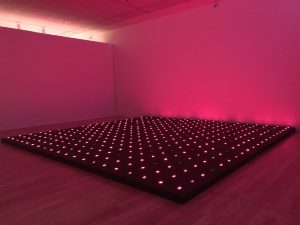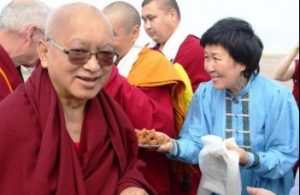My journey through India during the months of September and October has been a magical series of encounters: with Tai Situ Rinpoche; with the Ganden Tripa; and with Green Tara herself. My encounter with the female buddha, first at the Alchi monastic complex in Ladakh, guided me to meet an artistic couple based in in Dharamsala, the home of His Holiness the Dalai Lama and the Tibetan government-in-exile. The Thangka Painting School and the Himalayan Art Museum are institutions that teach and preserve the art of thangka painting. I met the school and museum’s founders, Master Locho and Dr. Sarika Singh, for lunch and a tour of the museum. They are a husband and wife who are making a considerable mark on the Indo-Tibetan art world.
Master Locho is an eminent thangka guru who has dedicated his life to the preservation and promotion of endangered Buddhist art. Master Locho studied under the guidance of Master Tempa Choephel, a teacher at the prestigious Norbulingka Institute located in Dharamsala. He subsequently became an acclaimed name in his qualified school of thangka lineage preservation. His majestic blue Medicine Buddha thangka still welcomes people at the arrival hall of Kangra Airport, and he was the onetime official thangka painter for the Dalai Lama.
My day with Master Locho and Dr. Singh was not complete without a guided painting session with the former. During this informal taster lesson, Master Locho shared with me some secrets of painting the Sun and Moon as motifs, the correct placement of Om Ah Hum behind deities, and how to identify a Buddhist lineage in each thangka. When I asked him if he had experienced any challenges as one of the founding thangka teachers of the Norbulingka Art Institute, he simply replied: “Yes, it was difficult.”
Meanwhile, Dr. Singh is the only qualified female thangka master in the world today, endorsed by His Holiness. This qualification is unique for the fact that she is female, non-Tibetan, and not usually based in Dharamshala. Together, they are the creators of a stunning series of paintings depicting the evolution of Tara, the female buddha of compassion, wisdom, and enlightenment.
In our interview, Dr. Sarika shared with me her challenges following her heart to paint thangkas. “I studied at Norbulingka Institute for a couple of years, and in my studio, I sat with almost 30 men. My initial drawings included several pencil drawings and paintings,” she told me. “I broke several conventions while on my journey. The first convention was that I always wanted more women to join thangka painting, since they were so few. Secondly, as I was learning this discipline, I departed from long courses, which were the only modules available. I began developing, structuring, and customizing short courses so that more people could attach themselves to this tradition, and the tradition can stay alive.”
Another convention Singh challenged was how she helped to develop the use of textbooks in thangka painting course, as they were initially not available to students. Throughout this journey, she faced the overarching challenge of creating a space where non-Tibetans and women could create a space for this art, irrespective of nationality, locale, and gender. “So when you are faced with so many challenges, you need strength,” Singh said. “And that one strength, that one lady, that one divinity, that one beauty, was Tara. She became my strength, my light, my beacon.”

The Tara series of paintings is exhibited in the Tara Gallery of the museum, which also displays a most impressive collection of thangkas made by Master Locho. I was amazed by the regal ambience of the Tara Gallery. It showcases nine masterpieces, through the image of Tara, that depict the journey of Buddhist art from India to Tibet and back again, highlighting the cross-cultural influence that first began eastward but has since returned to nourish Indian soil. These thangkas are painted in gold, silver, and minerals, and feature beautiful buddhas and bodhisattvas that left me awestruck. Currently, there are 40 masterpieces displayed at the museum, which took the couple more than 20 years to assemble.
I asked her the inspiration for this gallery, specifically. “I was once on Staten Island in New York City, where I visited a museum under the name of Jessie Marcus. I was so inspired by the Tara display there that I felt I had created this museum, maybe in my previous lifetime. But certainly in my present life, I knew the seed had been planted and I needed to make a museum to tell a story of my own.”
To further promote thangka painting, Singh is about to launch an online thangka-painting program.
The third of the paintings in the Tara Gallery’s series is a replica of the Alchi Green Tara as Prajnaparamita, a rare and exquisite mural that is hidden at the base of a colossal statue of Avalokitesvara in the Sumstek Hall of the Alchi complex. This was the same Tara I had encountered earlier on my trip (see my previous article). Master Locho said that he has painted more than 300 Green Taras, but his replica painting of the Alchi Tara is special: “She exudes deep kindness and compassion, most beautiful, like no other.” It took five years to complete. He explained that he used natural pigments and gold to recreate the vibrant colors and intricate details of the original mural. He also added some elements from his own vision, such as a hair ornament with a pair of gold ducks in her head.
Although Tara is commonly associated with Tibetan Buddhism, Singh feels that the goddess’s Indian connection is profound, and she is correct: after all, the earliest evidence of worship for Tara is found in India. (Lam 2014) “After 17 years of learning thangka painting, I became determined to re-establish this beautiful origin, the Indian origin that is close to my heart. My research of the earliest examples of Indian art took me to the Ajanta Caves, which I felt were calling to me. Every time I went to Ajanta, I felt like I had been there during a past life,” said Singh. “Whenever I went, I could easily relive the life of those artists who worked tirelessly to translate Buddhist philosophy into visual depictions. I absorbed a good deal of the Ajanta style.”
Her journey shifted further when she visited the mystical monastic complex of Alchi. “I entered Sumtsek Hall and was immediately struck by the Tara mural there. I had already read about this Tara. I had already drawn her. To my amazement, she looked exactly the same way that I had drawn her as. She was so close to me. No words could describe that feeling, that she had called me here to give me her blessings. It was as if he was saying, ‘You have done the drawing now. Look at me as much as you can, then go back and fill in the colors.’” She believes that Tara told her in her own celestial language, as she is a divine presence beyond human words: “So we went back and Master Locho, and I completed our Tara painting in five years.”
It is no surprise that Singh enjoys this mystical connection to the Alchi Tara—something that I felt as well when I was at Alchi. She pointed out its distinct features: “See how she looks to one side, while in most iconography we have Taras looking directly frontward? So here she is at a 45-degree angle, and you will also see that her style of attire is very different, indicating a unique blend of iconography that developed in Alchi at a unique point in history.” Such iconography has also been found in Tabo, Singh says. “And we can only say that this is a very distinct style of the 1,080 or so monasteries that developed in the Himalayan region.”
Singh points out that while monasteries in the Himalayas would have been commonly attacked or looted, effectively no one touched Alchi. “Maybe it was too secluded; you also have to cross a river to reach it. This has meant that the artists there must have been of a particular caliber and vision, and it shows in their unusual artwork: palm trees, nobles hunting and feasting at a banquet, dresses and tunics with leonine motifs and braided hair: they appear Central Asian, perhaps Persian: “The colors and style of painting are not typically Tibetan. Rather, they seem influenced by techniques brought from as far west as Byzantium.”
As we conclude our conversation, Singh draws my attention to the sheer magnificence of the Alchi Tara once more: “I would say that this is one of the most beautiful depictions of the female buddha that the artist could have given life to.” She also sees herself as a student of the Indian roots of the art she loves so much, along with the various intersections of different cultures (Persian, Indian, Kashmiri, Tibetan, and more): “So this geographical intersection throughout time, as well as the intersection of beauty and divinity, I would say, was one of the most beautiful things that touched me.”
My conversation with Singh left me with a richer insight into the world of thangka painting and the significance of Green Tara in Buddhist art. As one of my teachers, Tai Situ Rinpoche, said: “Art is not just about creating something beautiful, but it is also about creating something that has meaning. It is about creating something that has meaning, and that can inspire others.” Perhaps the essence of Buddhist art is to reveal the jewel for the practitioner that is ready, who possesses the correct insight.
References
Raymond Lam. 2014. “Legitimizing Legitimization: Tārā’s Assimilation of Masculine Qualities in Indo-Tibetan Buddhism and the Feminist ‘Reclaiming’ of Theological Discourse.” In Feminist Theology 22, 2. Accessed at: https://doi.org/10.1177/0966735013507853
Related features from BDG
The Tai Situpa, the Ganden Tripa and the Dalai Lama: My Meetings with Great Masters in India


















